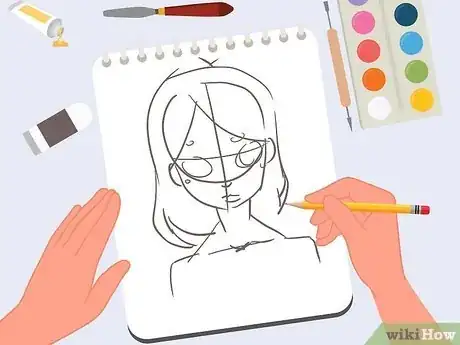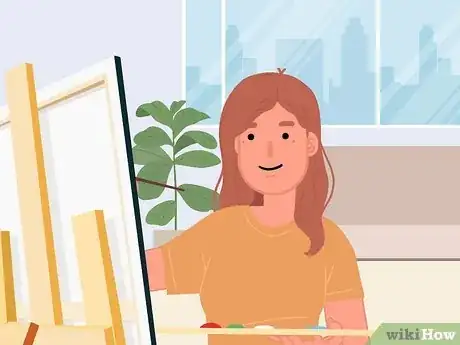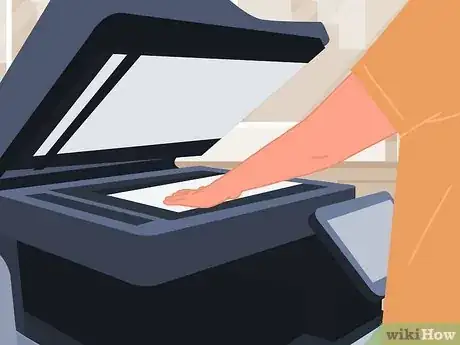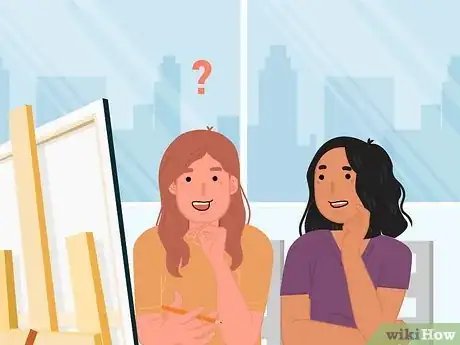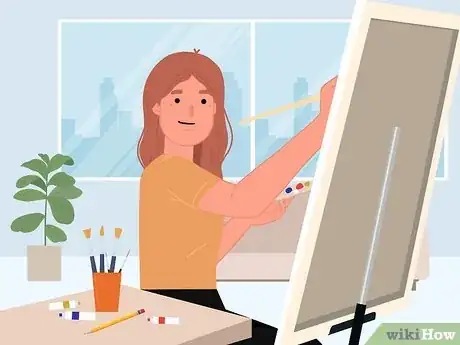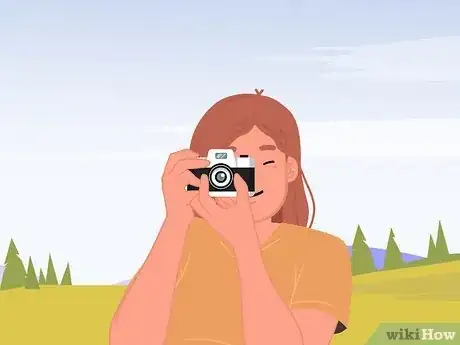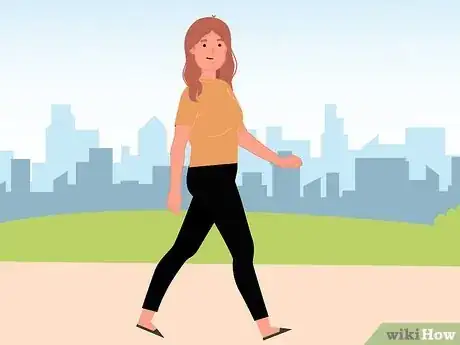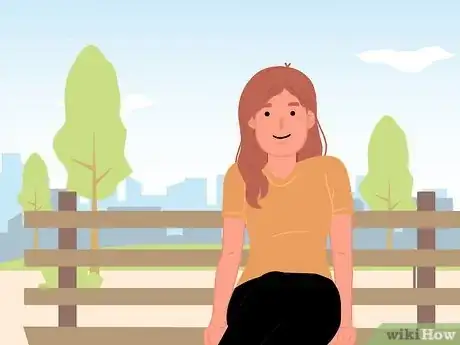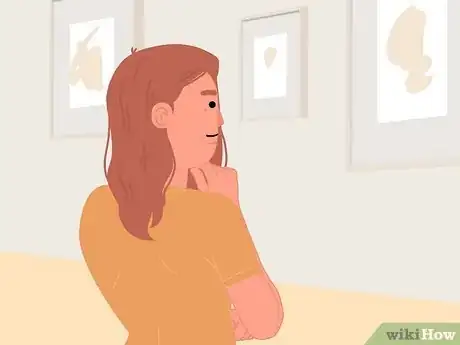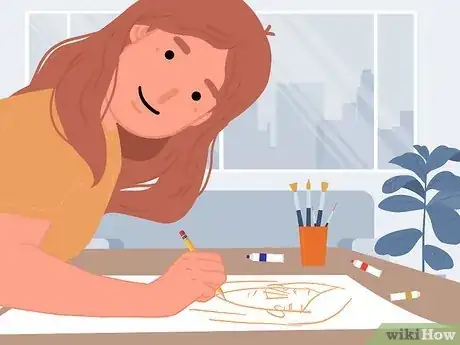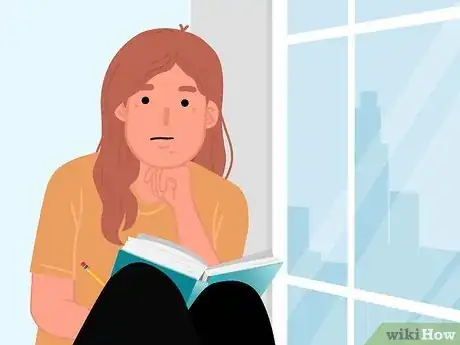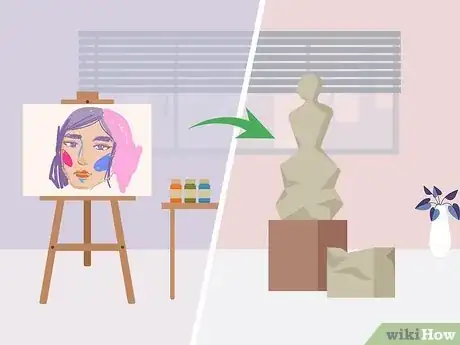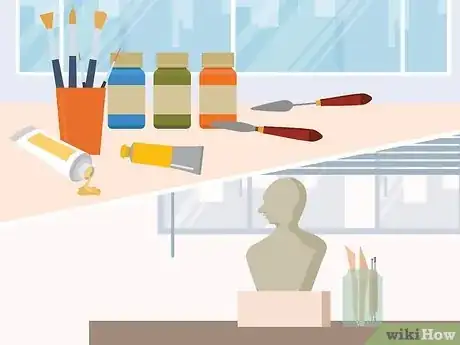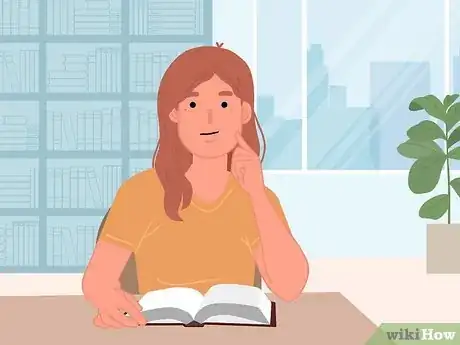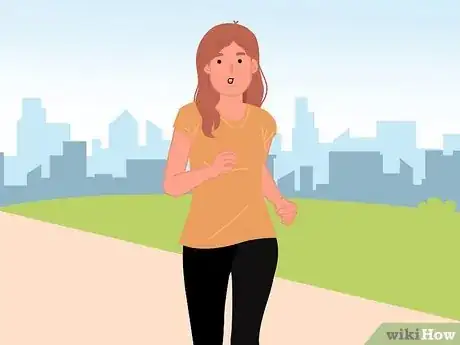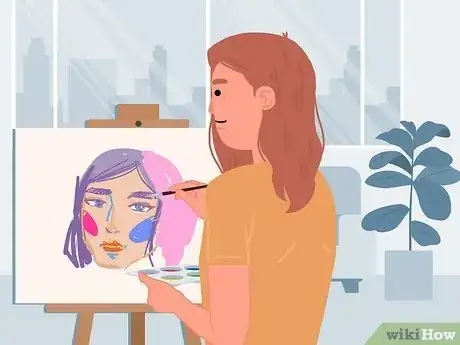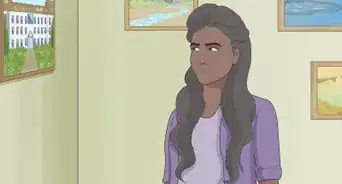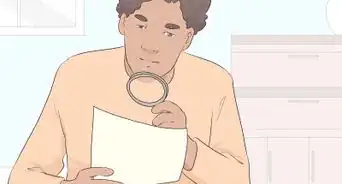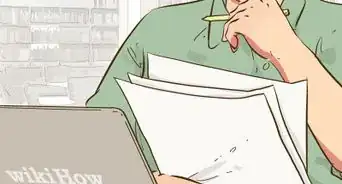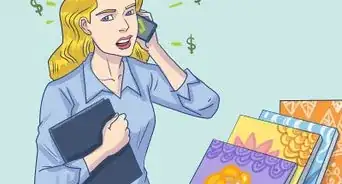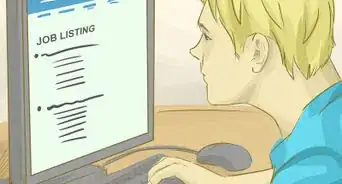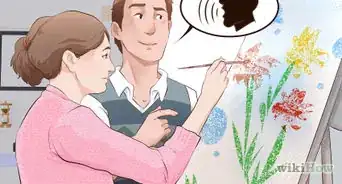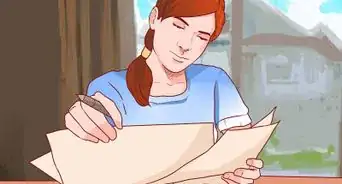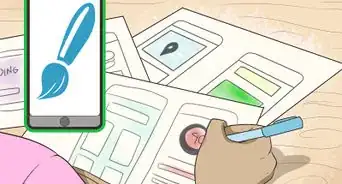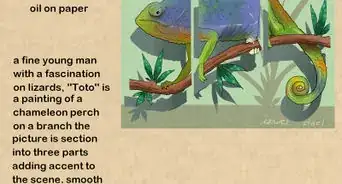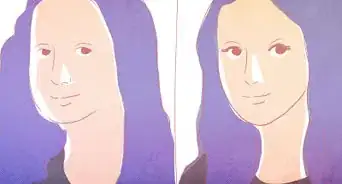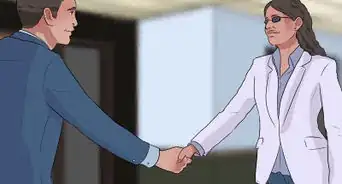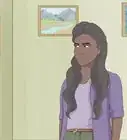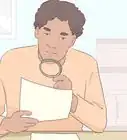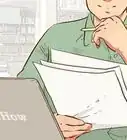This article was co-authored by Kelly Medford. Kelly Medford is an American painter based in Rome, Italy. She studied classical painting, drawing and printmaking both in the U.S. and in Italy. She works primarily en plein air on the streets of Rome, and also travels for private international collectors on commission. She founded Sketching Rome Tours in 2012 where she teaches sketchbook journaling to visitors of Rome. Kelly is a graduate of the Florence Academy of Art.
There are 9 references cited in this article, which can be found at the bottom of the page.
wikiHow marks an article as reader-approved once it receives enough positive feedback. In this case, several readers have written to tell us that this article was helpful to them, earning it our reader-approved status.
This article has been viewed 217,967 times.
It is not an unusual experience for an artist’s imagination or creativity to dry up. To bring inspiration back into your practice, you will need a lot of persistence and a willingness to play within new boundaries. Doing creative exercises, taking workshops, travel, seeing new places, starting some new research or applying to a residency can all help. At the end of the day, you just need to keep at it.
Steps
Using Creative Exercises
-
1Spend a month drawing something you love. Choose a subject matter that you love. For instance, if you love to draw doorways, choose doorways as an object of focus. Each day, for the next thirty days, create an artwork with doorways as a focus. It could be a painting, drawing, mixed media collage, short film, photograph or another media that you enjoy using.[1]
-
2Do ten paintings in ten minutes. A simple time limit can be useful. Put down ten pieces of newsprint on your studio floor or use small pieces of watercolor paper. Set your timer for ten minutes. Paint one sheet a minute.[2]Advertisement
-
3Redraw a photocopy of one of your drawings. Give yourself some time to draw something. Then, make fifty photocopies. With each photocopy, make a new sketch overtop of the old drawing. Try to find as many ways to alter the original drawing as you can imagine. You should redraw each of the fifty photocopies so that it looks like a completely new artwork.[3]
-
4Ask a friend for an assignment. If you have a mentor you trust, consider asking them for a creative assignment. It is important to ask somebody you know and trust, since they will be most likely to come up with an assignment that will challenge you.[4]
-
5Enroll in an art workshop. Search for workshops that introduce techniques or media that you don’t know, but which could help you build your art practice. By challenging yourself to try a new technique or process, you may find a way out of your artist’s block.[5]
- If you are an abstract paper, try a workshop on realist painting.
- If you normally paint in acrylic, try a workshop on oil painting.
- If you normally shoot digital video, try taking a workshop on super 8 film.
-
6Find something in your daily life that you want to draw or sculpt. Take photos of everyday things around you. Then go back through them and doodle aspects of those photographs. You could also try reframing photographs with a viewfinder or small frame. Zoom in on small parts of an image.[6]
- Find a muse. It can be a person or an animal or whatever inspires you.
Changing Your Environment
-
1Walk around the block. You may have spent too much time stuck in your studio. Give yourself a few minutes to take a walk around the block. Take your eyes off the pavement in front of you. Enjoy the sights, sounds and smells. A short walk can be energizing.[7]
-
2Take a break in an inspiring place. If you have been spending a lot of time in the studio recently, you may simply need to expose yourself to a new place or environment. You don’t need to necessarily go far to find inspiration. You could go to a new garden, find a lookout or a park you’ve never visited in your city. Take some time off in an inspiring place.
-
3Go on a trip. A roadtrip might be what the doctor ordered. Get in your car or book a flight to someplace you’ve always wanted to visit. Take your camera, sketchbook, journal and a few other art materials. Absorb and record your experience of the journey.[8]
-
4Do a residency. There are many artist residencies available that offer the opportunity to work in a new place and with new people. Look into the qualifications and timelines. Find one that you feel is a good fit and send in an application. You may get the chance to spend time in a park, a new city, on the high seas, in a hotel, a gallery or an artistic community.
- For instance, the National Parks have an artist-in-residence program.[9]
-
5Reconnect with nature. Spend some time outside in a park or garden. Go for a hike or arrange some flowers in your garden.[10]
- If you can’t leave the city, spend some time in urban nature, such as a local park or garden.
- If you have some vacation time coming up, go to a wilderness area. Get away from all the noise and find inspiration in nature.
Changing Your Creative Routine
-
1Make time and space for your practice. In order to overcome artist’s block, you need the time and the space to do it. First, make sure you have a place to work. It could be a gorgeous loft but, if the resources for a nice studio are unavailable, it could also be your kitchen table. Then, make sure you have the time to work. Set aside a specific amount of time and commit to it on a daily basis.[11]
- If your studio is messy, it is important to clean it up. However, don’t spend time cleaning as an excuse not to work.
- If you are unhappy with some aspect of your studio space, it makes sense to address it. For instance, if you don’t like the wall color, perhaps you should paint your studio.
-
2Take a break from email and technology. If you tend to spend a lot of time in front of a computer or answering emails on your smart phone, you may benefit from a timeout. Take a day away from technology and just focus on your creative practice.[12]
-
3Switch projects. If you feel stuck with one creative project, you could switch to a different project. Perhaps spending time with a different project will give you inspiration for the project that is making you feel blocked.[13]
-
4
-
5Visit a library or bookstore. Browse through the nice books. Do some research on a topic you’ve been wanting to explore.[15]
- Visit a big book store and go to the art or photography books section. Sit on the floor and peruse to your heart's content.
-
6Take care of yourself. Neglecting your bodily, emotional and spiritual needs cramps creativity. Spend a little more time on the masterpiece of you. Get your body moving and eat a solid meal.[16]
-
7Start where you are. There will always be excuses to avoid making time for your creative practice, such as fear of making “bad art” or everyday chores that get in the way. At the end of the day, you need to give yourself permission to make something. It may take a little courage and persistence, but you need to start somewhere!
- Throw some paint on a canvas. Release any emotional stress that might be in you.
- The important thing is to wake up in the morning and jump into something.
- Start with something easy, such as preparing a canvas.
- Persistence is the key. As artist Chuck Close says, “Inspiration is for amateurs – the rest of us just show up and get to work.”[17]
Expert Q&A
-
QuestionWhat can help my creativity flow?
 Kelly MedfordKelly Medford is an American painter based in Rome, Italy. She studied classical painting, drawing and printmaking both in the U.S. and in Italy. She works primarily en plein air on the streets of Rome, and also travels for private international collectors on commission. She founded Sketching Rome Tours in 2012 where she teaches sketchbook journaling to visitors of Rome. Kelly is a graduate of the Florence Academy of Art.
Kelly MedfordKelly Medford is an American painter based in Rome, Italy. She studied classical painting, drawing and printmaking both in the U.S. and in Italy. She works primarily en plein air on the streets of Rome, and also travels for private international collectors on commission. She founded Sketching Rome Tours in 2012 where she teaches sketchbook journaling to visitors of Rome. Kelly is a graduate of the Florence Academy of Art.
Professional Artist To overcome artist’s block, start doing other things that are just for fun. Try sketching, doodling, or exploring with new materials. Do something every day that is different from what you normally do and nothing that has the pressure of a deadline. Create things that won’t be shown to anyone; things that are more about playing to reconnect with being an artist.
To overcome artist’s block, start doing other things that are just for fun. Try sketching, doodling, or exploring with new materials. Do something every day that is different from what you normally do and nothing that has the pressure of a deadline. Create things that won’t be shown to anyone; things that are more about playing to reconnect with being an artist. -
QuestionWhat do I do if I have an idea but I don't know how to draw it?
 Community AnswerLook at examples of art involving that subject by other artists. Study it and try to recreate what they did. It may take several attempts. Then take parts of what they did and what you learned to make your own art. To avoid any copyright claims, don't post your studies on social media.
Community AnswerLook at examples of art involving that subject by other artists. Study it and try to recreate what they did. It may take several attempts. Then take parts of what they did and what you learned to make your own art. To avoid any copyright claims, don't post your studies on social media. -
QuestionThere are alot of artists who develop very identifiable "styles" of art, how do I develop my own style?
 Community AnswerYou have to give yourself time to develop your voice and style. Find work that inspires you. Stay persistent.
Community AnswerYou have to give yourself time to develop your voice and style. Find work that inspires you. Stay persistent.
Warnings
- Don't start thinking about whether a piece will sell or not. Just do it for yourself.⧼thumbs_response⧽
- The fear of making "bad art” can come from comparing your art to others. Instead, compare your art to previous projects to see how much you have improved.⧼thumbs_response⧽
References
- ↑ https://www.brainpickings.org/2014/02/28/creative-block-krysa/
- ↑ https://feltmagnet.com/misc/10-ways-to-overcome-artists-block
- ↑ https://www.fastcompany.com/3045143/10-techniques-from-professional-artists-on-how-to-break-through-creative-blocks
- ↑ https://www.fastcompany.com/3045143/10-techniques-from-professional-artists-on-how-to-break-through-creative-blocks
- ↑ http://www.finearttips.com/2010/08/10-ways-to-overcome-mental-blocks-boost-creativity/
- ↑ http://www.artistsnetwork.com/articles/inspiration-creativity/art-therapy-how-to-overcome-artists-block
- ↑ https://www.fastcompany.com/3045143/10-techniques-from-professional-artists-on-how-to-break-through-creative-blocks
- ↑ https://www.fastcompany.com/3045143/10-techniques-from-professional-artists-on-how-to-break-through-creative-blocks
- ↑ https://www.nps.gov/subjects/arts/air.htm
- ↑ http://www.finearttips.com/2010/08/10-ways-to-overcome-mental-blocks-boost-creativity/
- ↑ http://www.finearttips.com/2010/08/10-ways-to-overcome-mental-blocks-boost-creativity/
- ↑ http://www.finearttips.com/2010/08/10-ways-to-overcome-mental-blocks-boost-creativity/
- ↑ https://www.brainpickings.org/2014/02/28/creative-block-krysa/
- ↑ https://www.thoughtco.com/how-to-beat-artists-block-2573760
- ↑ https://medium.com/kickstarter/14-ways-to-overcome-creative-block-80ed620a7a43
- ↑ https://www.entrepreneur.com/article/234932
- ↑ https://www.brainpickings.org/2014/02/28/creative-block-krysa/
